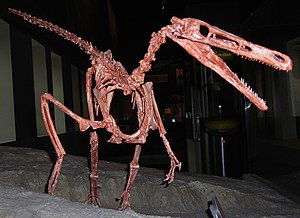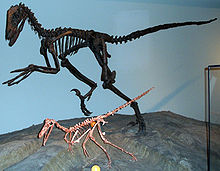Buitreraptor
| Buitreraptor | ||||||||||||
|---|---|---|---|---|---|---|---|---|---|---|---|---|

Buitreraptor gonzalezorum in the Field Museum of Natural History |
||||||||||||
| Temporal occurrence | ||||||||||||
| Upper Cretaceous ( Cenomanium ) | ||||||||||||
| 100.5 to 93.9 million years | ||||||||||||
| Locations | ||||||||||||
| Systematics | ||||||||||||
|
||||||||||||
| Scientific name | ||||||||||||
| Buitreraptor | ||||||||||||
| Makovicky , Apesteguía , Agnolín , 2005 |
Buitreraptor is a genus of theropod dinosaur from the group of Dromaeosauridae . Remains of this animal come from the early Upper Cretaceous ( Cenomanium ) of the Argentine province of Río Negro .
So far, an almost complete skeleton and a partial skeleton are known. Buitreraptor was scientifically described in 2005 with the so far only species Buitreraptor gonzalezorum . It is attributed to the Unenlagiinae , a group of basal dromaeosaurids from the southern continents .
features
Buitreraptor was a small Dromaeosauridae with an estimated length of 1.25 m and a weight of 4.7 kg. The length of the femur (thigh bone), an important size for length comparisons, was about 14.5 cm.
The skull was flat and proportionally significantly longer than most other theropods; so it exceeded the femur in length by 25%. The flat and thin nasal bone indicated a long and thin snout, similar to that of Velociraptor . Like other dromaeosaurids, Buitreraptor had good spatial vision, as indicated by the triangular shape of the skull when viewed from above. Very atypical for dromaeosaurids are the very small, unsawed teeth that were placed in the jaws at a larger distance from one another.
As with other dromaeosaurids, the tail was reinforced by mechanical fasteners - elongated prezygapophyses and chevron bones . In contrast to the dromaeosaurids of Laurasias , in which a single one of these vertebral outgrowths could overlap up to ten preceding vertebrae, the prezygapophyses in Buitreraptor were pointed and only overlapped half of the first preceding vertebra. A unique feature of Buitreraptor was the wide, robust and pneumatized (hollowed-out) wishbone (furcula). The pubis was aligned vertically - a common feature of all Unenlagiinen. The metatarsus is arctometatarsus-like with a tapered third (i.e. the middle of the three large) metatarsal bones in the upper section - a feature that also occurs in other dromaeosaurids from the Lower Cretaceous and is considered "primitive" for this group.
Find and naming
The finds come from "La Buitrera", a rich fossil site of the Candeleros Formation , a member of the Neuquen group . The fluvial sandstones of this site are known for their very well-preserved, three-dimensional skeletons of small tetrapods , such as sphenodontids , crocodiles from the group of Araripesuchids , primitive, boned snakes and mammals such as dryolestoids , while dinosaurs are rare. However, other nearby outcrops of the Candeleros Formation contained the remains of large dinosaurs such as Rebbachisaurids , more basal titanosaurs, and Carcharodontosaurids .
The holotype material of Buitreraptor (specimen number MPCA 245) is an almost complete skeleton of an adult animal with only parts of the lower legs and arms and the rear half of the tail missing. Another find (copy number MPCA 238) is a partial skeleton that consists of pelvic bones, the sacrum and the right hind leg. Both finds are in the collection of the Museo Carlos Ameghino in Cipolletti .
The name Buitreraptor refers to the place where it was found "La Buitrera" ( Spanish el buitre - "vulture"), where raptor means "robber". The Artepitheth gonzalezorum honors the brothers Fabián and Jorge González, who helped with the field work in “La Buitrera” for years.
literature
- Peter J. Makovicky , Sebastián Apesteguía, Federico L. Agnolín: The earliest dromaeosaurid theropod from South America. In: Nature . Vol. 437, No. 7061, 2005, pp. 1007-1011, doi : 10.1038 / nature03996 (alternative full-text access: ResearchGate ).
Web links
Individual evidence
- ^ A b Alan H. Turner, Diego Pol, Julia A. Clarke, Gregory M. Erickson, Mark A. Norell: A Basal Dromaeosaurid and Size Evolution Preceding Avian Flight. In: Science . Vol. 317, No. 5843, 2007, pp. 1378-1381, doi : 10.1126 / science.1144066 , digitized version (PDF; 507.41 kB) , Supporting Online Material (PDF; 755.11 kB) .
